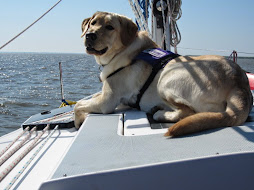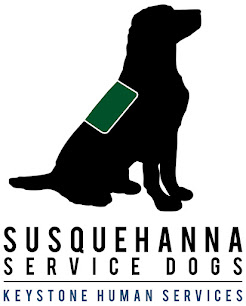SSD Irwin has been working extra hard on two cues: “heel”
and “leave it.” When Irwin has finished learning “heel,” he will be able to
swing his back legs around until he’s standing to the left side of his handler.
“Heel” is a useful cue, and it’s one of the cues that all of our dogs learn.
Irwin is still learning “heel,” and Donna is using a heel
box to help him. He puts his front feet on the box, and then Donna clicks and
treats him for moving his back feet to the right. We start teaching “heel” by
clicking and treating the dog for putting their front paws on the heel box. Then
we watch for the back legs to move toward the right. If the dog is just
standing there, we may take a step to the right, which often prompts the dog to
move in the same direction. As soon as we see the back legs move, we click and
treat.
“When Irwin first started doing the heel box, he got right
up,” says Donna. “I waited for those back legs to move, and move they did—just like
a donkey kicking his back legs up and out!” Now Irwin will hop up on the heel
box and move his back legs several steps. He’s not quite in the heel position
yet, but he’s getting there. Watch the video of him and Donna working on “heel.”
If you’ve been reading our blog, you’ve probably heard us say
over and over that “leave it” is one of the most important cues our dogs learn.
It’s true! For example, if the dog’s partner drops pills on the floor, the dog
will need to ignore them until they can be cleaned up, which could be hours,
especially if their partner isn’t able to clean them up themselves. Check out
this video of Irwin practicing “leave it.” Donna surrounds him with all of his
favorite things: a water dish, toys, bones with peanut butter in them, and
kibble. And then an unexpected distraction shows up. Watch how Irwin reacts.
He handled that extra distraction (family dog Hunter) pretty
well, didn’t he? Nice training session, Irwin!
We like this video because it shows a training session in
the heat of the moment. If you focused on Irwin when you watched the video,
watch it again, but this time, focus on Donna. What does she do when Irwin
stands up?
“In the rush of things, I use both verbal and hand cues when
it should be one or the other,” says Donna. We train our puppy raisers to use
either the verbal cue or the hand signal, but not both at the same time. If the
dog always gets both cues, we don’t know which one he’s reacting to, and so we
don’t know if he actually knows both cues.
However, this is the perfect example of what often happens
in the heat of the moment. During training sessions or out in public, things
happen quickly, and our puppy raisers need to react quickly, giving cues and
reacting automatically. Sometimes we unthinkingly use two cues, and sometimes
we use the wrong cue for what we want the dog to do. The amazing thing is that
it gets easier with practice, and often the dogs are able to figure out what we
wanted them to do, even when we accidentally say the wrong cue.
Dogs aren’t the only ones who learn in each training
session. The puppy raiser learns just as much. With each training session,
puppy raisers become better clicker trainers. It’s always a learning
experience, especially for puppy raisers who have raised multiple dogs. Each dog
is different and the training techniques that worked for one dog might not work
on the next one. Our puppy raisers are constantly learning.
Irwin and Donna recently went shopping at Walmart on the same day as
the local rest home. Because Irwin is still a puppy, he sometimes pulls ahead,
and since Donna knew that the store would be full of people using canes,
walkers, and wheelchairs, she decided to use the comfort trainer so she would have
more control over him. At the store, there was one gentleman who seemed
especially curious about Irwin and followed them around with his cart. When he
saw Donna giving Irwin a treat, he said, “So that muzzle he has on doesn’t
interfere with him getting treats.”
Although she was busy shopping, Donna took the time to
explain about service dog training and that a comfort trainer is very different
from a muzzle. The comfort trainer fits around the dog’s head, but it doesn’t
inhibit their movement in any way. They can eat, drink, bark, and more with a
comfort trainer on. It’s merely a tool to give handlers more control over the
dog, which can be especially helpful for partners who may not have the strength
to prevent their dog from pulling ahead.
After Donna talked with the gentleman for a while, he said, “He
[Irwin] sure seems happy to be shopping and watching you.” He and Irwin had a
nice greeting that ended with Irwin giving him puppy kisses on his hand. An
excellent end to an education opportunity!











No comments:
Post a Comment